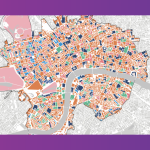Our city level cost-of-living index is updated yearly, so in this section we draw upon national-level inflation data. In July 2022, UK inflation rate hit 10% year on year and overtook inflation rates in the US, France, Germany and Hong Kong. The UK’s dependence on natural gas and its use to set the marginal price for electricity production has left the country exposed. Recent analysis indicates that British households pay the highest average electricity price of any European country. The energy price cap announced for the UK, will have some downward impact on inflation but there will be longer-term impacts on borrowing and interest rates.
The GLA has conducted analysis showing that Londoners are experiencing faster inflation in food and rent prices than elsewhere in the UK, leading to one in five Londoners stating they are financially struggling. As a result without government intervention, London is the UK region with the highest share of households for whom food and energy bills are projected to exceed disposable income over 2022 and 2023.
Inflation in France continues to trail that of the UK, USA, and Germany. Its government’s price cap on electricity and natural gas for households is likely to be the reason for this variation. It will however expire at the end of the year. Oxford Economics, a consultancy, has undertaken analysis indicating that London and Paris are less affected by rising energy prices in proportionate terms than the rest of their respective countries. This is most likely due to lower car ownership levels and higher residential density. French energy caps, plus the renationalisation of EDF, have been combined with a cap of 3.5% on increases in private rent, but are set to rise this autumn.
In the longer term, the European Commission has pushed for EU members to use emergency price caps on wholesale gas, either on a state-by-state or pan-European basis. The government of Norway has indicated that its state-owned oil group Equinor, may be willing to sell gas at controlled prices to European countries if granted longer term contracts, which may help to limit rises. German inflation is likely to rise as government cost-of-living measures, including the nine euro train ticket, expire in September.
In contrast, in the US, one measure of industrial inflation – PMI input prices for manufacturing – have begun to fall significantly. This should flow into lower consumer prices. Data from the New York City Comptroller indicates that inflation is significantly lower in New York than across the rest of the country some 6.7% in June 2022 as opposed to 9.1% nationally. Previous analysis from the city government explains that, as in London, increased reliance on public transit is shielding many New Yorkers from rising fuel prices. Rent stabilisation in the city has also suppressed the effect of rising rents on overall inflation rates. Hong Kong remains significantly unaffected by inflationary pressures, due to falling housing costs, which make up 40% of the Consumer Price Index on the island.


